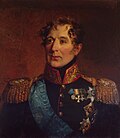Russian Empire
In the 1750s, in a re-settlement initiated by Austrian Colonel Ivan Horvat, a vast number of Orthodox Serbs, mostly from territories controlled by the Habsburg monarchy (the Serbian Grenzers), settled in Russia's military frontier region of New Serbia (with the centre in Novomirgorod, mainly in the territory of present-day Kirovohrad Oblast of Ukraine), as well as in Slavo-Serbia (now mainly the territory of the Luhansk Oblast of Ukraine). In 1764, both territorial entities were incorporated in Russia's Novorossiya Governorate. Serbs continued to settle in Russian lands, and many, such as Sava Vladislavich, Nikolay Depreradovich, and Peter Tekeli, became high ranking generals and imperial nobility.
During the Napoleonic Wars, many Russian generals were either Serbian-born or of Serbian descent, including Georgi Emmanuel, Peter Ivelich, Nikolay Vuich, Ivan Shevich, and multiple others. The most esteemed Serb in the service of the Russian Empire at the time of the Napoleonic Wars was Count Mikhail Miloradovich, a leading commander during the French invasion of Russia and governor-general of Saint Petersburg.













